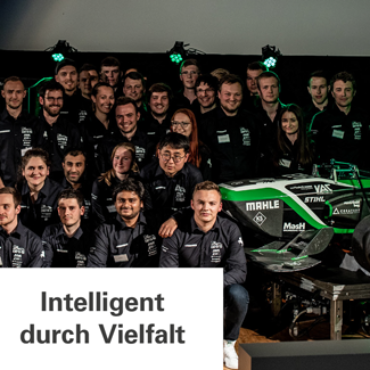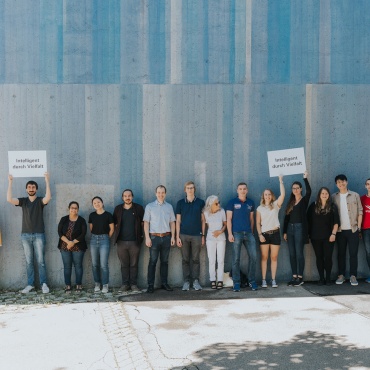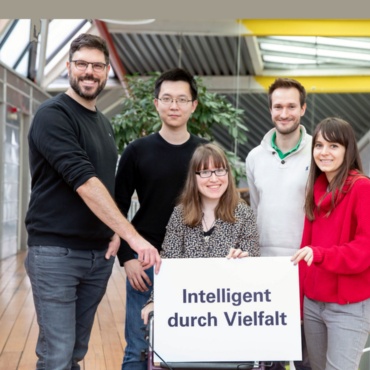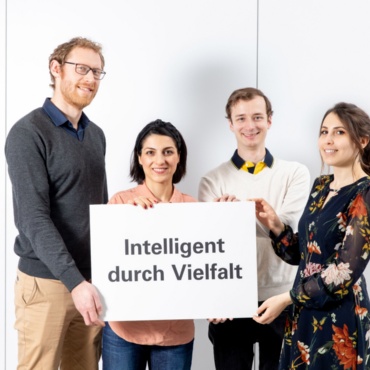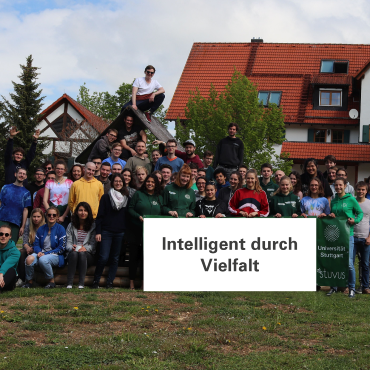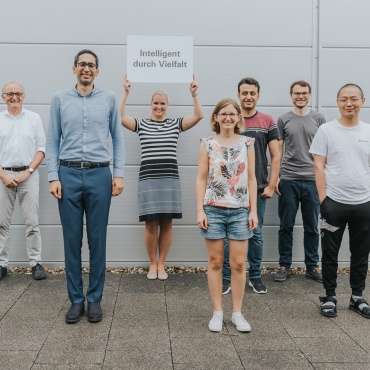The Stuttgart Way strongly influences the guiding principles of networked disciplines – a very important part of the University of Stuttgart’s profile. Cultural diversity and the consistent cooperation between complementary subjects encourage different ways of thinking. This approach can be seen in Team LH².
The research group at the Department of Hydromechanics and Modelling of Hydrosystems (LH²) is part of the Institute for modelling Hydraulic and Environmental Systems and was brought to life in 2000, when Prof. Rainer Helmig took over as department director. The aim of the group is to ensure close interdisciplinary work between the fields of research, teaching and lifelong learning courses, as well as technology transfer in the engineering sector.
Introducing the team
The team at the Department of Hydromechanics and Modelling of Hydrosystems (LH²), currently comprises 29 people. These include professors, postdoctoral researchers, doctoral researchers, system administrators and administrative employees of various nationalities and from different generations. The employees come from a range of different disciplines. The team includes mathematicians, physicists, civil engineers, simulation scientists and environmental technicians from Germany, Norway, the USA, India, Iran, China and Finland.
The interdisciplinary research work generally involves modelling flow, transport and deformation processes in porous media for use in various applications. There is a balanced relationship between basic research and applied research.
For example, areas of application for research work at the department include:
- Pollutant dispersion underground
- Thermally driven remediation technology
- Storage of CO2 in deep geological formations
- End storage problems
- Methane migration from decommissioned mines
- Gas-water management in fuel cells
- Filters
- Drying and salinizing the ground
- Gas storage underground or flow and transport in vascular vessels and tissues in the body
The huge range of the topics listed makes it clear that the issues are socially relevant and can only be solved by an interdisciplinary team. The diverse cooperation in the department reflects the interdisciplinary and international character of our research work.
The research group LH² is currently working on various international and interdisciplinary projects and the group’s work is also integrated into research associations at the University of Stuttgart. One example of this is the group’s involvement in the internationally aligned Collaborative Research Center (SFB) 1313, where processes in porous media are researched, headed by Prof. Rainer Helmig – this project is funded by the DFG. The department is represented with 5 projects in the SFB. In the SimTech cluster of excellence, the department is represented with 3 research projects. As a member of the seven-member Board of Directors, Rainer Helmig is also involved in the management of the cluster. The department is also involved in the international graduate college DROPIT (GRK) 2160, where it also has a research project.
The National Water Supply is a long-term partner of the department, researching alternative resources to tackle the effects of climate change.
The department also takes part in various collaborations with the Federal Office for Radiation protection, with whom it is currently working on modeling hydrodynamics and material transport in water-bound transport processes in radiation protection in terms of gaining clearance approval for weak radioactive substances.
International and interdisciplinary research is extremely important at LH². The DAAD programs are often used to increase collaborations with students at other universities. The department is currently involved in a cooperation with ENIT in Tunisia. The research groups at LH² and at ENIT are working together on an environmental application, investigating salinization processes in porous media where evaporation processes develop.
For us, it is a matter of course that different genders, generations, nationalities, and cultures work together at the department. For the research group, the exchange of information at various levels and between different fields of expertise, different generations or different cultures is an enormous advantage for the department and it also helps to expand one’s personal horizon. Diversity is especially important to us and for the working environment at LH2, and, consequently, for successful research. The department is brought to life by the diversity of the people who work there and the diversity of the projects.
One of the department’s successful projects is the Open Source Software DuMux. This was developed at LH2 at the beginning of 2007 and has been used and developed by the entire research group ever since. With DuMux, it is possible to program models for vastly different applications in the field of flow, transport and deformation processes in porous media. Simulation can be conducted based on these models:
- Gas storage (CO2, H2, CH4, ...)
- Environmental remediation problems
- Transport of therapeutic active ingredients through biological tissues
- Root-ground interaction
- Underground-atmosphere coupling (Navier Stokes / Darcy)
- Pore network modelling
- Flow and transport in porous media
And much more...
The development and optimization of DuMux is a team effort. The program benefits from the work of our research group and the research projects by our employees benefit from DuMux. The scope of DuMux goes beyond the University of Stuttgart; it is also used by international research groups. A lively exchange has developed with our international networks. DuMux is brought to life by the diversity of its users and their research projects. Without ongoing contributions from the research group, DuMux would not have become what it is today; an important research tool in the field of modelling and simulation.
About the series “Diversity Promotes Intelligence”
In a series of articles, we will be introducing teams who view diversity as a matter of course. The motivation behind this series, is the University of Stuttgart’s new diversity concept, initiated by the Vice Rector for Early Career research and Diversity.
Diversity promotes intelligence
[Photos: GTUS-Max Partenfelder, o.A., o.A., o.A., o.A., o.A., o.A.]




